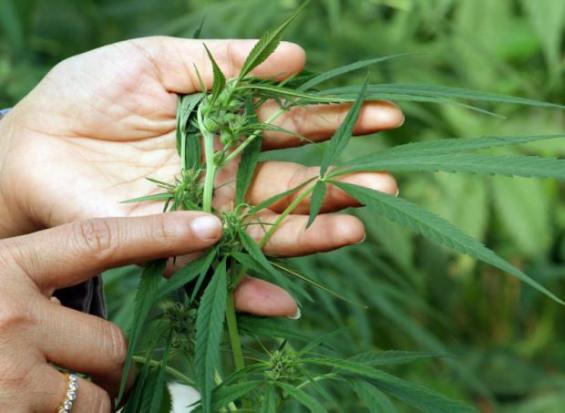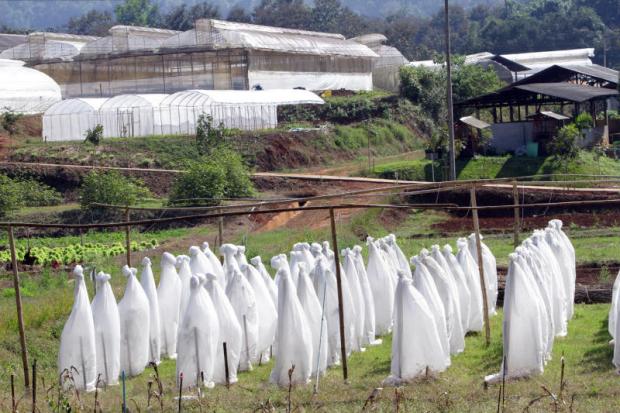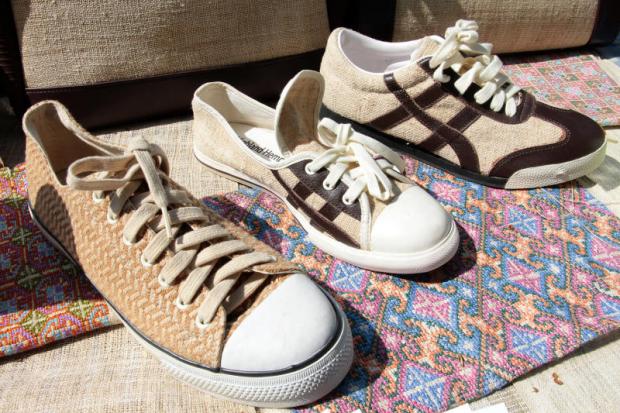
Pilot project: Hemp is grown at the Pang Da agricultural station in Samoeng district of Chiang Mai.
Grown in the past by the Hmong highland communities of northern Thailand, mainly for use as special clothing for corpses during the hill tribe minority's funeral ceremonies, hemp is now seen as a plant with the potential to become a significant cash crop for the kingdom.
Despite being categorised as a Type 5 narcotic, much research has been conducted to pave the way for turning hemp into a legal plant that can be grown more freely and supplied as a material for several industries.
A lot of this research has gone into the many practical uses that this incredibly versatile material can be put to, with new products made of out hemp fibre being invented every day.
Among these products is a hemp-fabric surgical mask invented by a group of Math- ayom 4 students at Ratchasima Witthayalai School in Nakhon Ratchasima province.
Called "The Mask Sativa" by the team, led by Dusita Tunjindaprateep, the reusable hemp-fibre mask beat two other popular fabrics -- cotton and lotus -- in tests of its utility, both in terms of fibre quality and its air-filtering efficiency.
Because her school is located on Mittra- phap Road which suffers from polluted air due to the high recorded volume of dust and carbon monoxide particles, finding a way to help her fellow students mitigate the problem sparked Ms Dusita's interest in figuring out a way to produce washable surgical masks to filter the filthy air.
For her science project at the school, Ms Dusita said she and her team of fellow students undertook research to find the type of plant fabric that would best suit their needs. The team chose cotton, lotus and hemp with the aim of comparing each plant's efficiency in filtering carbon monoxide and dust particles from the air.
As it turned out, the hemp fabric achieved the best results in filtering both pollutants, she said.
Each surgical mask produced by the team is made of strips of hemp fabric measuring 1.5 inches wide and 15 inches long.
Despite its Type 5 narcotics status, hemp is a very high quality of fibre -- flexible, strong and durable, said Sarita Pinmanee, a researcher with the Highland Research and Development Institute (HRDI).
Hemp is a plant that has a key role in the way of life of the hill tribe people and is also a part of the culture of certain ethnic minorities living in the highland areas, particularly the Hmong, she said.
After it was found that the local species of hemp grown by the hill tribe villagers contained an even higher amount of tetra- hydrocannabinol (THC), the narcotic substance, than marijuana, the HRDI has developed an alternative hemp species consisting of less than 0.3% THC. Marijuana contains 0.4% THC.
The difference between hemp and marijuana plants, Ms Sarita said, is that the hemp stands far taller than the marijuana and also grows wider and larger leaves.
She also advocated the economic value of hemp as a crop, saying that it can easily be used to produce several types of products including clothing, fertilisers, animal feed, food supplements, drinks, cooking oil, flour, butter, beer, furniture, construction materials, packaging materials, auto parts and bulletproof vests.
These potential uses raised hopes among the researchers studying the benefits of hemp that the government might amend the law to allow the plant to be grown commercially which could create a new, employment-generating industry, she said.
The good news came on Jan 6 when a ministerial regulation designed to relax controls on the use of hemp took effect, 360 days after it was announced in the "Royal Gazette" said Pratchya Taweekul, head of a working group on the issue at the Office of the Narcotics Control Board's (ONCB) institute for narcotic plant survey and monitoring.
Every year since 2010, when a strategy to promote hemp as a new cash crop was launched, the ONCB has considered revising its rules regarding its harvesting, said Mr Pratchaya.
There are currently two types of hemp being grown in the country, he said. One is the traditional species cultivated by the Hmong people, especially those living in Tak's Phop Phra district. The highlanders harvest the plants and extract the fibres for traditional cloth weaving, he said.
The other type is the hemp farmed under a pilot project to promote the use of the plant in five provinces, namely Chiang Mai, Chiang Rai, Tak, Nan and Phetchabun, he said.
The growing of both types of hemp is closely monitored through site visits and aerial surveys conducted by the ONCB in order to ensure the growers strictly comply with the law.
As hemp still is generally recognised as a Type 5 narcotics plant, there must be a state agency that is responsible for regulating and monitoring the industry, said Ms Sarita.
The agency is also responsible for registering the growers, ensuring they sign a legally-binding document regarding their practices and supplying them with hemp seeds, which are available only through the HRDI.
More importantly, she said, the crucial part of the agreement signed with the growers is that they will have to minimise the amount of THC present in the hemp they grow.
Samples of the hemp plants grown under these agreements are regularly tested to ensure the growers are complying with the law, she said.
It is custom handed down through generations of Hmong people that anyone who dies without hemp fabric clothing wrapping their body will not be able to find his or her ancestors in the afterlife, said Kasem Saesong, a former headman of Ban Mae Sa Noi, a Hmong community in Chiang Mai's Mae Rim district.
The hemp-growing season normally begins in June, and, when the plants are mature enough, the process of turning hemp into fabric, which usually takes around three months, begins, he said.</p>
<p>However, since growing hemp is more complicated than it used to be, especially due to the strict legal controls, fewer villagers are willing to do it, he said.
Despite the economic potential of the crop, Mr Kasem said he was concerned that the cultivation of hemp will disappear from his community as young people are neither learning the skills from the older generation nor interested in negotiating the legal hurdles put in place by the authorities.


Huge potential: Cannabis sativa, known as hemp, can be used to produce a range of products including clothing, anti-pollution masks and even sneakers.
No comments:
Post a Comment